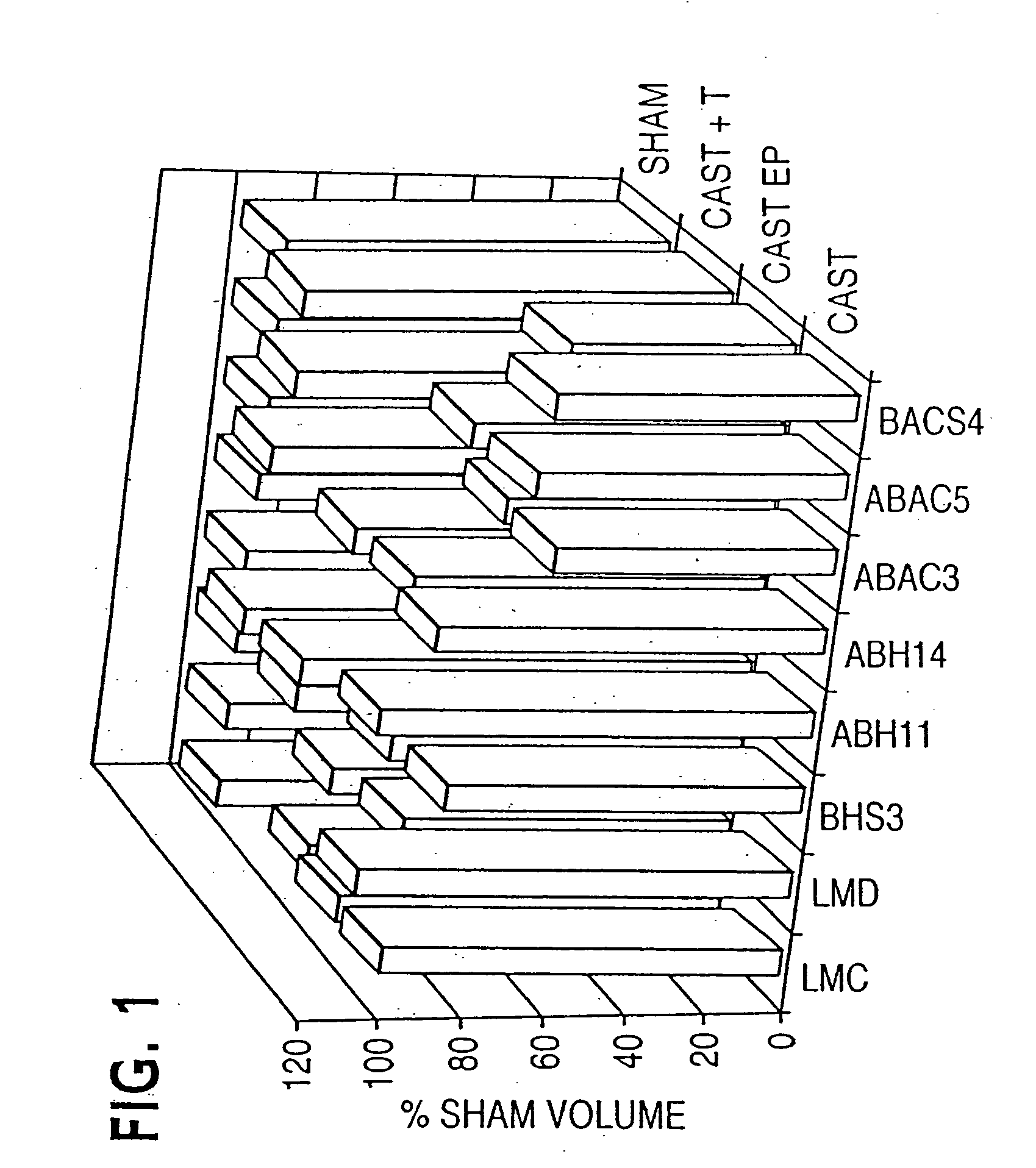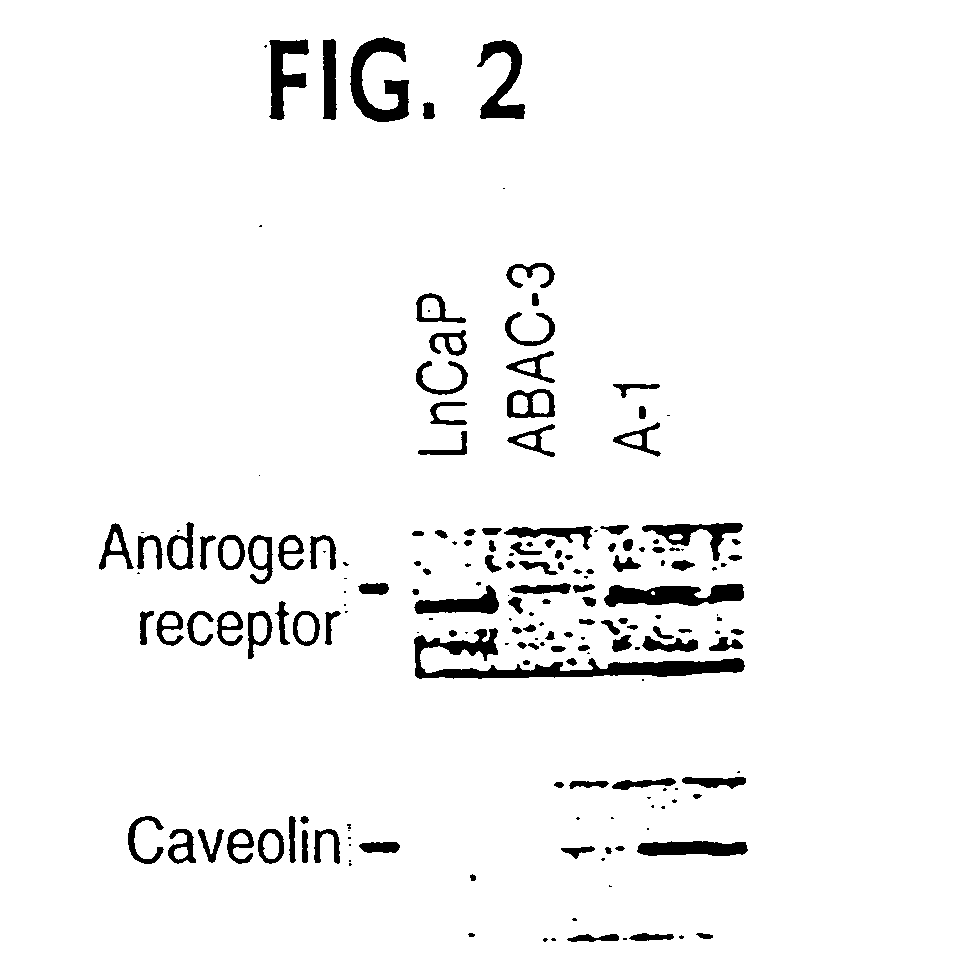Methods for the treatment of neoplastic disorders with anti-caveolin agents
a technology of anticaveolin and neoplastic disorders, applied in the field of neoplastic disorders with anticaveolin agents, can solve the problems of difficult to eradicate and treat, difficult to cure, and almost invariably detrimental disruptions in the normal physiology of cell division
- Summary
- Abstract
- Description
- Claims
- Application Information
AI Technical Summary
Benefits of technology
Problems solved by technology
Method used
Image
Examples
examples
Example 1 Caveolin Immunoassay in Human Prostate Cancers
[0115] Primary site human prostate tumors and metastases were isolated and analyzed for caveolin expression by immunoassay. The results of the assay are shown in Table 1. Metastases show higher levels of caveolin proteins in metastases than in primary tumors. Immunohistology of tissue sections reveals both elevated levels and distinct distribution of caveolin protein in metastatic human prostate when compared to a primary human prostate tumor.
TABLE 1PatientsPrimary-siteMetastases in lymph node1+++2+++++3+++++4++++5++6++++7+++++8++9−−10++11++12++++13++14+++++
example 2
Correlation of Caveolin Expression and Androgen Sensitivity
[0116] In this example, molecular pathways of castration-induced regression in mouse prostate cancer vis-á-vis the caveolin overexpression model are determined. Specific apoptotic activities and gene activities previously shown to accompany castration-induced regression in both rodent and human model systems are assessed. Differential display (DD)-PCR is used to identify specific gene activities that are directly related to castration-induced regression using the unique model system of the present invention, and specific signal transduction pathways are evaluated.
[0117] Levels of caveolin expression may be correlated with androgen sensitivity. This phenomenon is also reversible. Correlation experiments are performed using a single androgen-sensitive caveolin antisense clone (ABAC3) and re-selecting for the androgen-insensitive phenotype by passing this cell line as an orthotopic tumor through a series of castrated male host...
example 3
Development of Transgenic Mice with Overexpression of Caveolin
[0129] Transgenic mice are generated in which overexpression of caveolin is targeted to the prostate gland. Analysis of these mice is undertaken to determine the extent of developmental abnormalities and pathological changes that occur. Hormone manipulation of these mice allows study of prostatic growth and morphogenesis. The mice are also useful for therapeutic studies in vivo.
[0130] ICR mice have been constructed and injected with the MMTV-caveolin transgene FIG. 5 depicts the construct used for generation of transgenic mice. The human caveolin cDNA was cloned from human prostate mRNA by PCR amplification and sequenced in both directions to confirm the absence of mutations. It was then inserted into pKCR which was specifically chosen to facilitate cDNA transgene expression due to the presence of sequences for the β-globin spice donor and acceptor and bovine growth hormone poly-adenylation. Expression in this vector is ...
PUM
| Property | Measurement | Unit |
|---|---|---|
| metastatic disorder | aaaaa | aaaaa |
| nucleic acid | aaaaa | aaaaa |
| mass | aaaaa | aaaaa |
Abstract
Description
Claims
Application Information
 Login to View More
Login to View More - R&D
- Intellectual Property
- Life Sciences
- Materials
- Tech Scout
- Unparalleled Data Quality
- Higher Quality Content
- 60% Fewer Hallucinations
Browse by: Latest US Patents, China's latest patents, Technical Efficacy Thesaurus, Application Domain, Technology Topic, Popular Technical Reports.
© 2025 PatSnap. All rights reserved.Legal|Privacy policy|Modern Slavery Act Transparency Statement|Sitemap|About US| Contact US: help@patsnap.com



